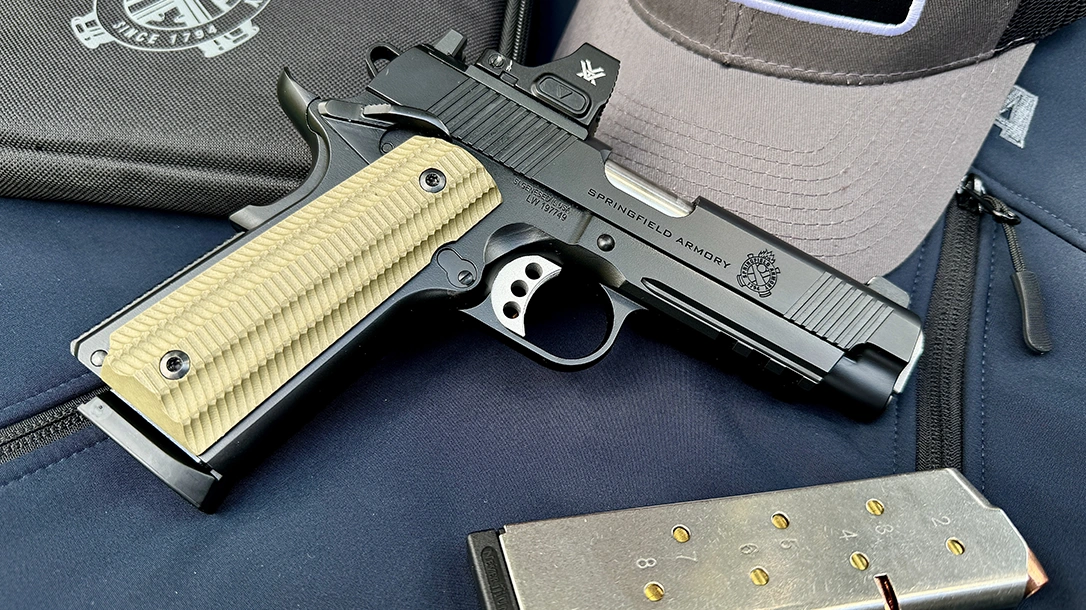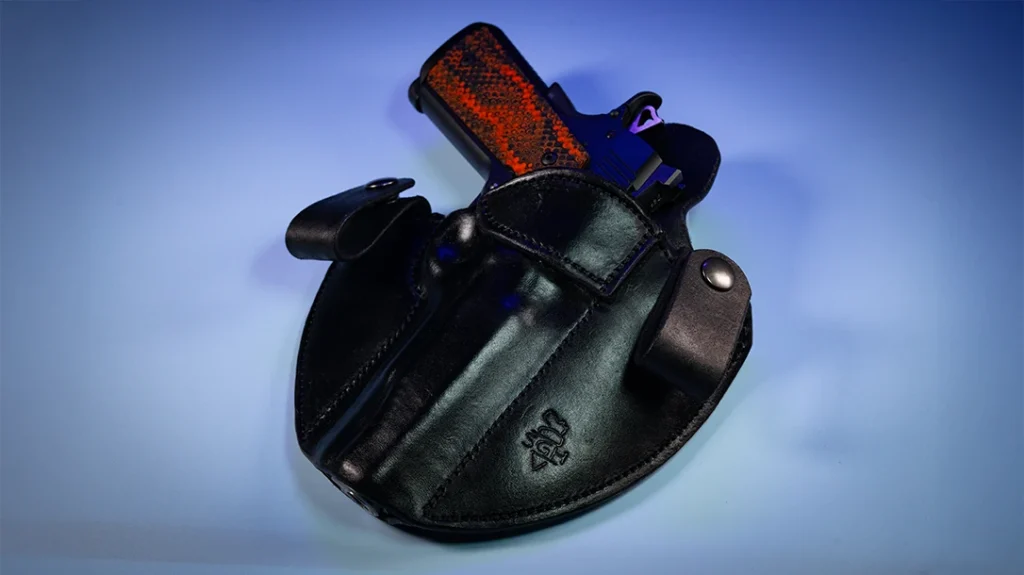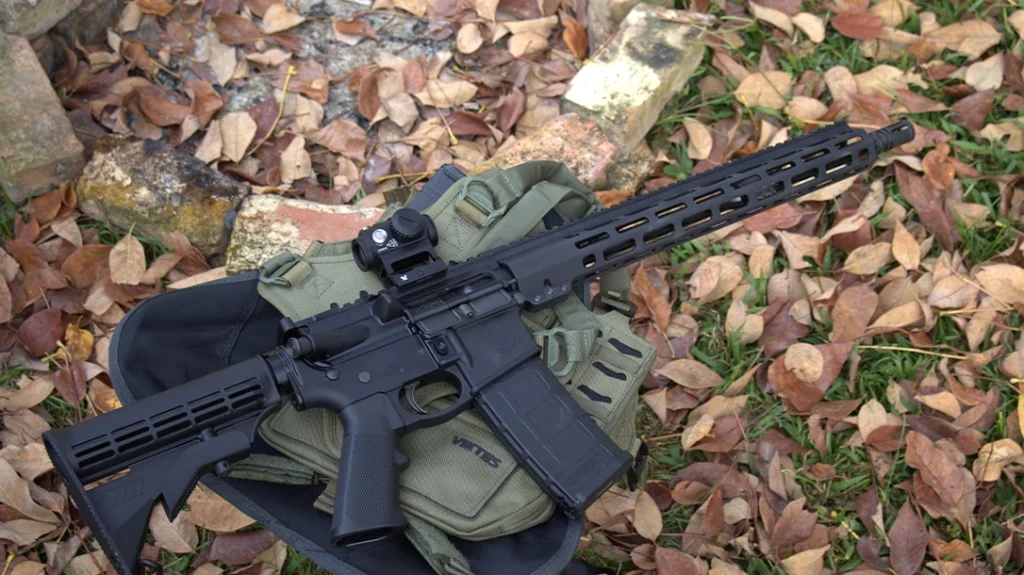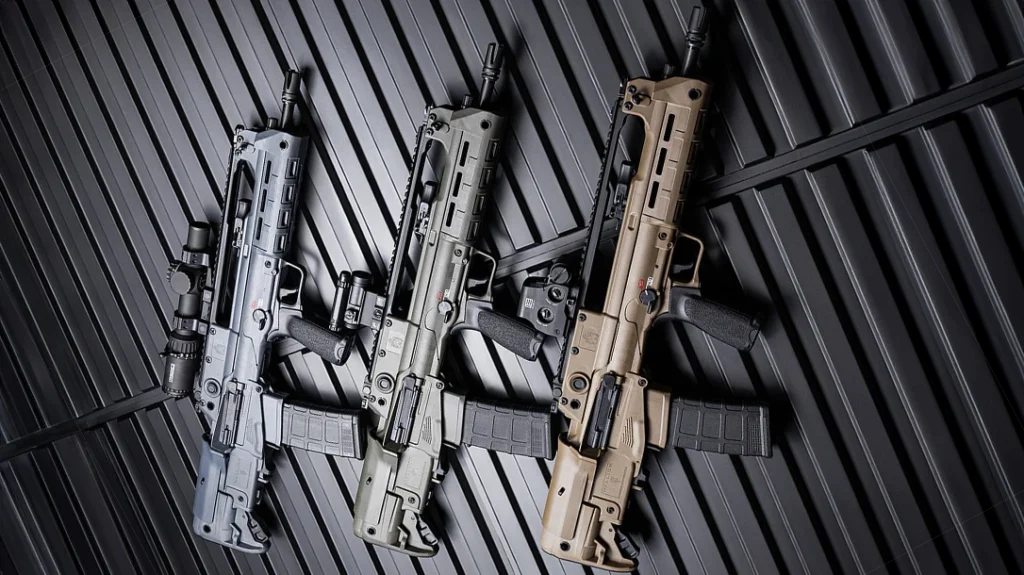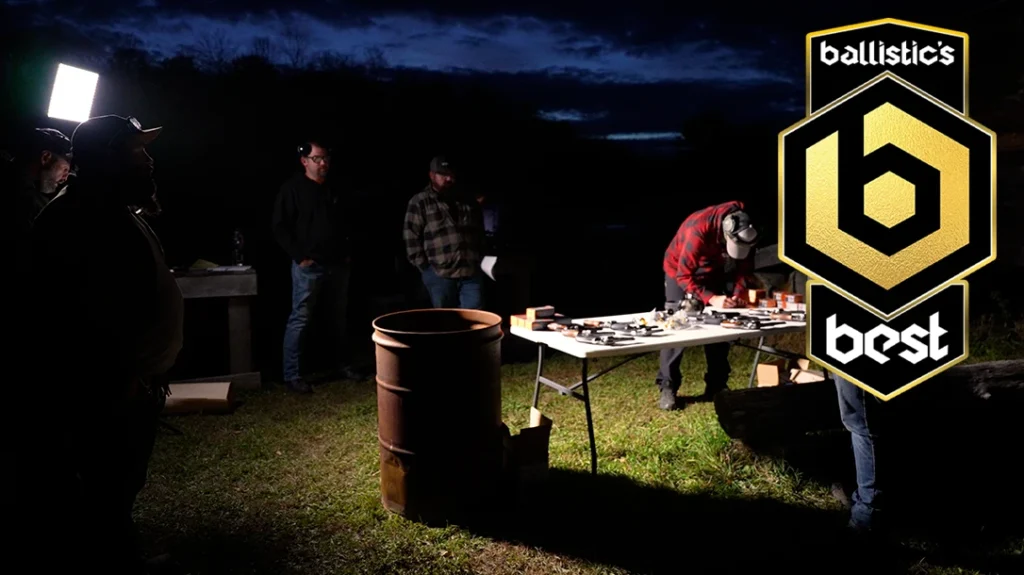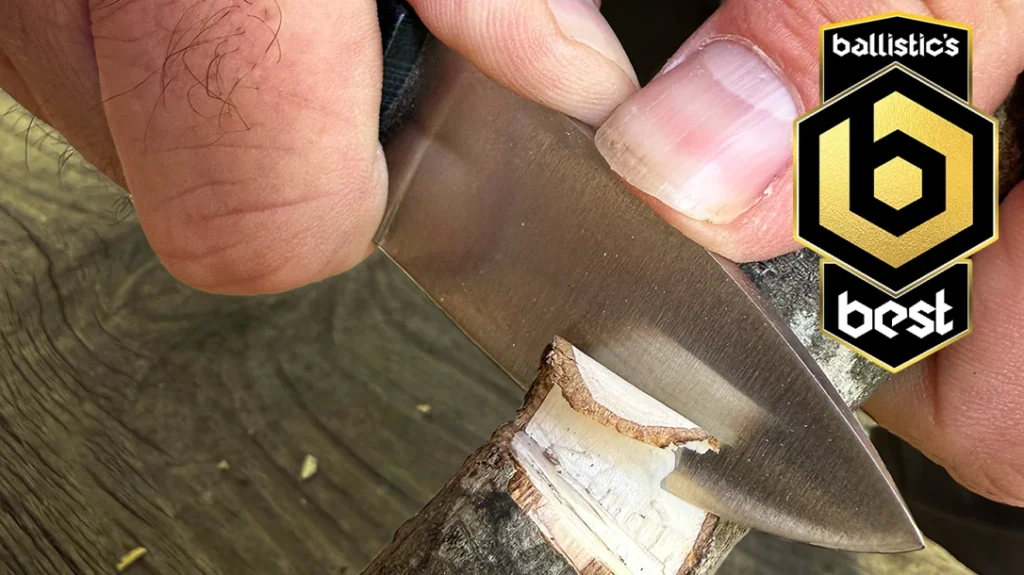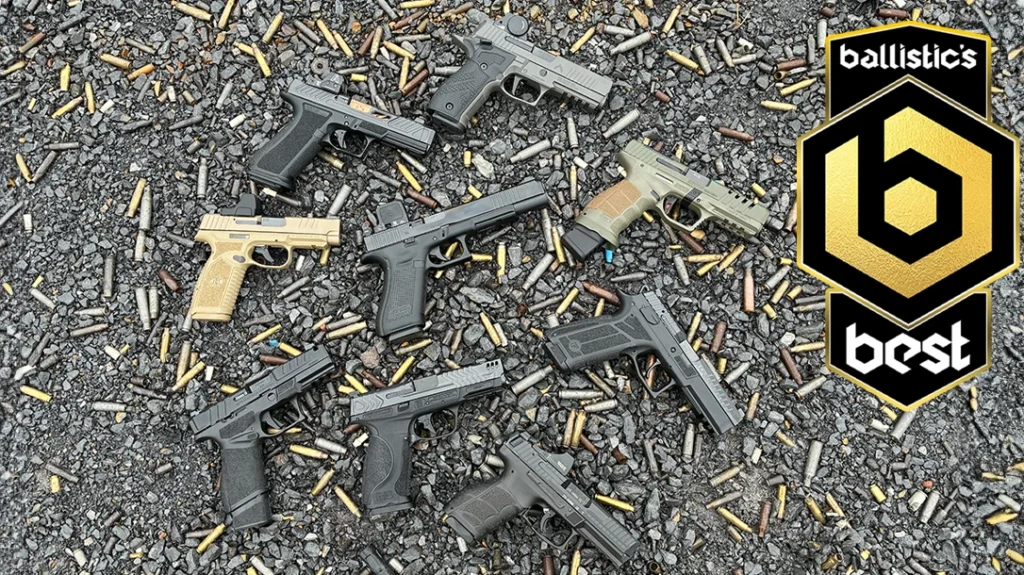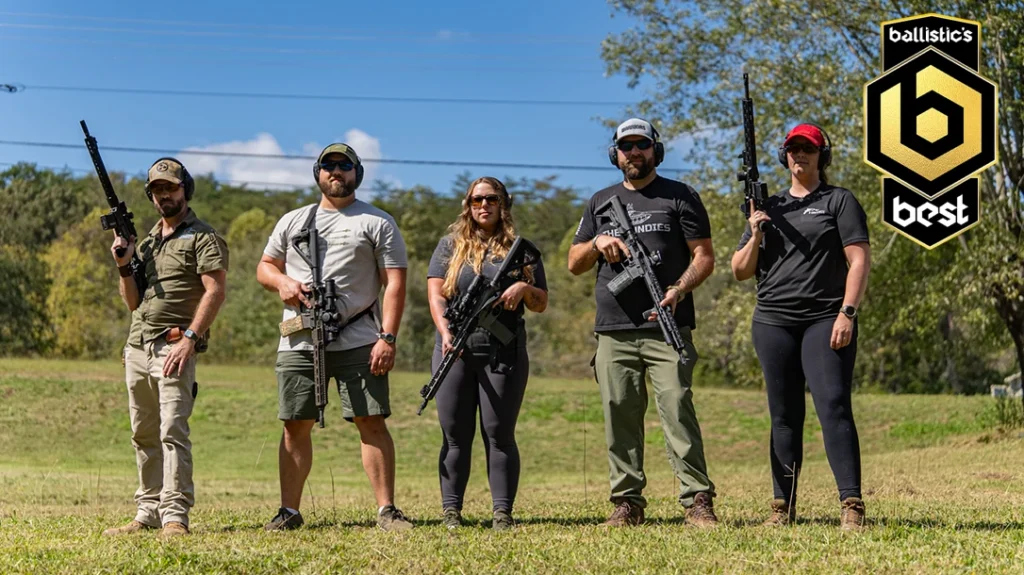The ubiquitous Model 1911 pistol has to be one of the most often-modified handguns on the planet. Following the experiences of WWI, the military asked for some external changes that resulted in the Model 1911A1 in 1924. Then, in the late 1940s, Colt created the Commander, a 1911 with a 4.25-inch barrel and an aluminum frame, hoping the military would adopt it. Instead, it became a civilian favorite and spawned a steel frame version called the Combat Commander. Now, Springfield Armory is upping the Commander-size 1911 game by adding an optic-ready slide with its Operator AOS.
The Springfield Armory 1911 Operator 4.25” AOS
I’ve always felt the Commander has the proper balance of barrel/slide length and overall height, which makes it just right. Nowadays, many manufacturers are cranking out Model 1911-type pistols, and you wonder—what else can be done to this old warhorse? Well, here’s the newest wrinkle.
Springfield introduced the Operator in late 2021. It was a small line in the 1911 series, which included some 47 different models at the time. The Operator came with a 5-inch barrel in 9mm or .45 ACP and offered several “duty-grade” features. These included a Tactical Rack rear/tritium front sights, G10 grips, ambi thumb-safety, forward cocking serrations, Picatinny rail, black Cerakote finish, and two 8-round magazines.
Advertisement — Continue Reading Below
Added to these were other features that used to be the strict domain of custom 1911s. These include an extended beaver tail grip safety, flat mainspring housing, loop-style hammer spur, adjustable trigger, and match-grade stainless steel barrel. Quite a package.
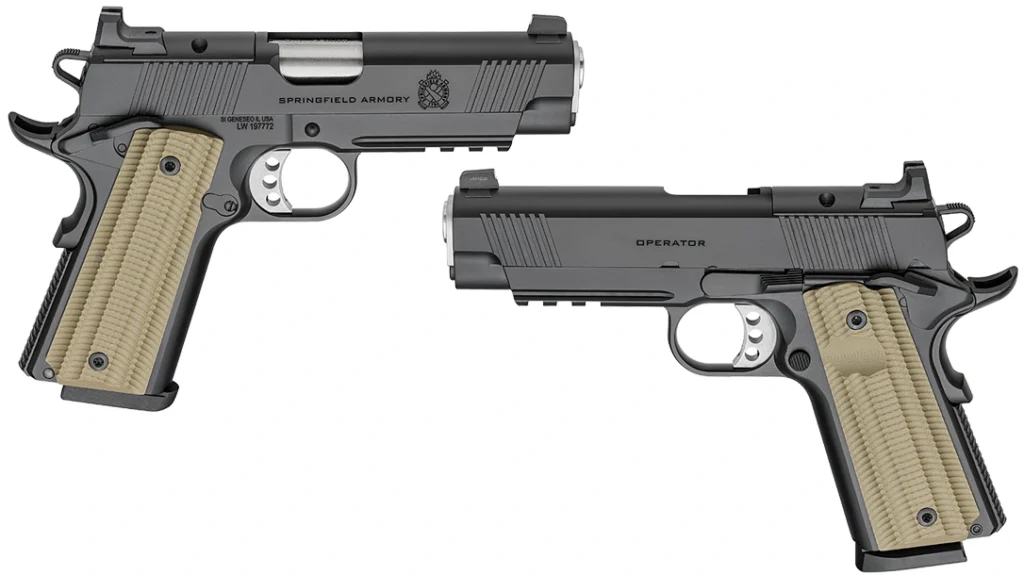
Now, Springfield is debuting the Operator with its new AOS (Agency Optics System), in collaboration with Agency Arms. Besides the AOS, you can also get a 4.25-inch barrel in 9mm or .45 ACP. An aluminum frame version is also available. I decided to T&E an Operator with a 4.25-inch barrel in .45 ACP, with an aluminum frame, and put in my order.
Advertisement — Continue Reading Below
My 1911 Operator 4.25 AOS came in a black pasteboard box that included a safety padlock, information packet, four MRDS adapter plates with screws, and a hex wrench. Each AOS model will come with a cover plate, and buyers will get a discount price on an adapter plate of their choice.
Additionally, there was a black nylon zipper carrying case. Inside was the Operator pistol, plus a spare 8-round Mec-Gar magazine.
The Operator’s Fit and Finish
Close examination of the Operator indicated first-rate fit and finish. The flat-black Cerakote application was even and non-reflective. Only the silver-colored trigger, barrel bushing, and stainless-steel barrel are not black.
Advertisement — Continue Reading Below
The VZ G10 grips are an OD Green color, with flutes running length-wise and terrace-like texturing. It sounds weird, but it really provides a firm hold. Added to that is a flat mainspring housing with chevron-cut style texturing. The extended beavertail grip safety has a memory bump, and the target trigger is adjustable for overtravel.
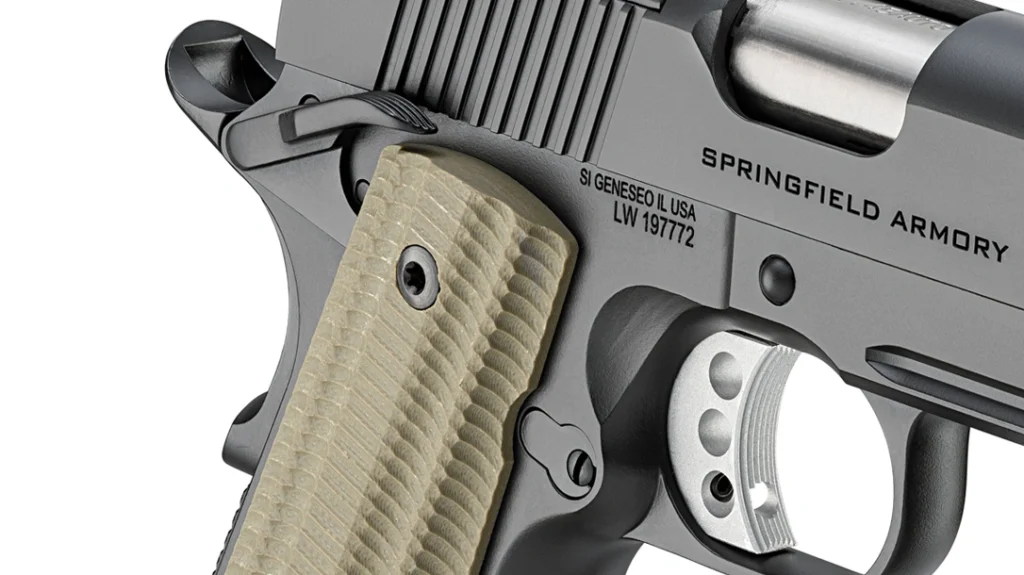
My Lyman trigger pull gauge said the average pull weight was 5 lbs. 2 oz., but it felt lighter. Correspondingly, there was a trace of take-up and no over-travel.
Advertisement — Continue Reading Below
The ambi thumb safety is extended and has serrated upper surfaces. The Picatinny rail has three slots and is integral to the frame dust cover. However, the slide stop and magazine catch are strictly GI.
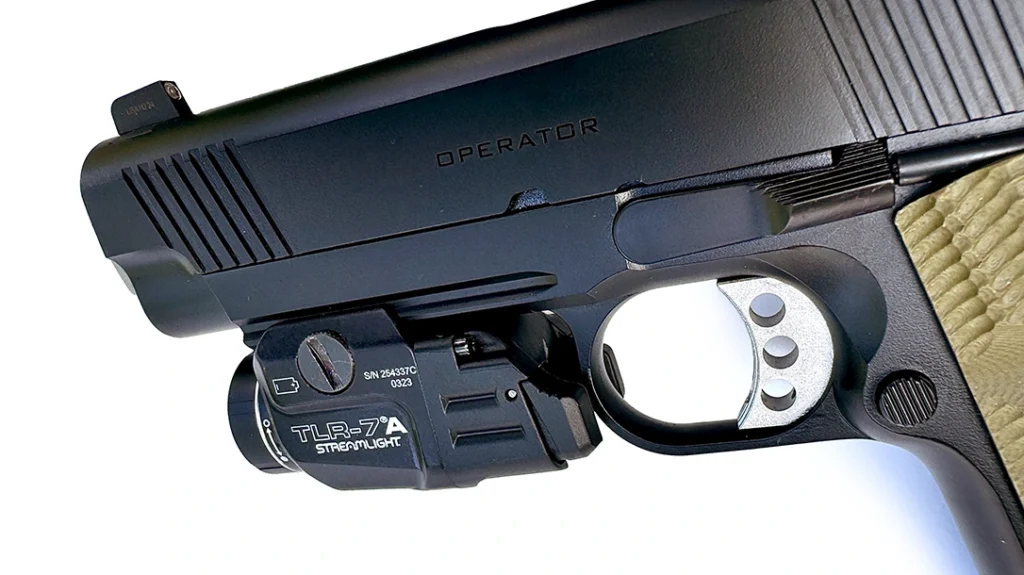
The front sight is dovetailed into the slide, slopes forward slightly, and has a tritium capsule embedded in the rear surface. The Tactical Rack fixed rear sight is dovetailed into the optics-cut cover plate. It has a U-notch and serrated rear surface.
Advertisement — Continue Reading Below
Extra-height fixed rear sights are also dovetailed into each of the billet steel optic adaptor plates. The four plates provided allow the mounting of all popular dot-type optical sights.
A Red Dot Ready 1911
I requested that Springfield send my test Operator pistol with an MRDS attached. The optic furnished was a Vortex Defender-CCW 3 MOA red dot. This compact unit is 1.6”x1.1”x1.0” and weighs just 0.9 oz. with the CR1632 lithium battery.
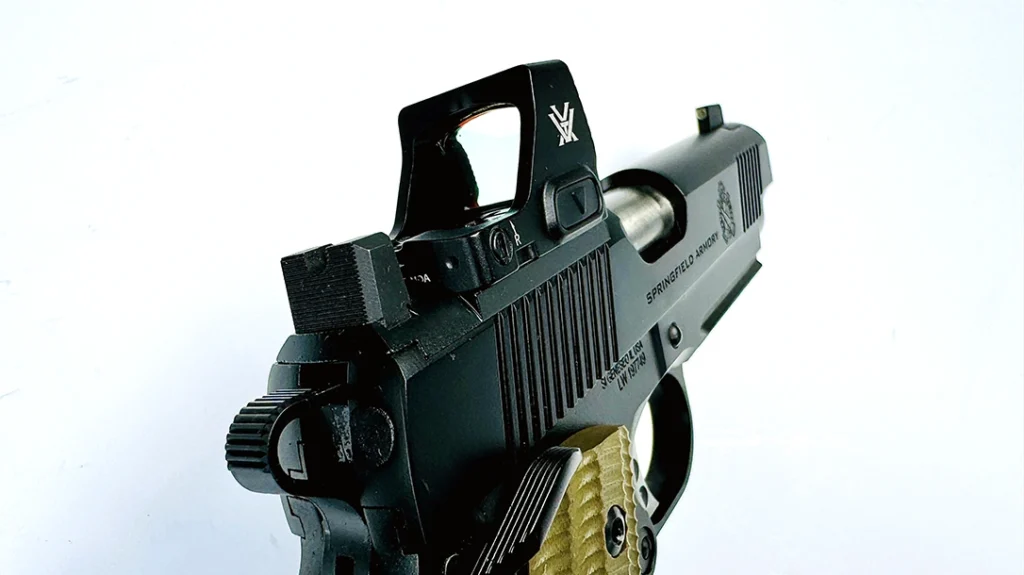
Advertisement — Continue Reading Below
The sight has 1x magnification, unlimited eye relief, and is parallax-free. There are ten illumination settings and up to 9,500 hours of battery life. Other features include motion activation with auto-shutoff and a button lockout that prevents accidental adjustments while carrying.
It offers a class-leading window size, exceptional optics, and minimal distortion for a truer sight picture. Setting adjustment buttons are situated on each side, and the front of the ShockShield polymer cover is checkered for fast slide racking. The Vortex Defender-CCW co-witnessed perfectly with the Operator iron sights.
Readying for Range Time
For the T&E, I selected five different brands of .45 ACP ammunition with varying bullet weights. All were hollow points of differing configurations.
Advertisement — Continue Reading Below
The first was Barnes TAC-XPD Defense Handgun load, which has a 185 gr. black-colored, all-copper (AC) HP bullet at +P pressure levels. Next was Cor®Bon DPX Compact Gun Load. It has a 160 gr. AC HP bullet with internal serrated cuts. Then I picked Federal’s Train + Protect, which has what they call a “Versatile” 230 gr. JHP bullet.
Gorilla Ammunition sent me their Silverback FBI Load, which also has an AC 230 gr. HP bullet designed for penetration and expansion. Lastly, I chose Remington’s Golden Saber Bonded cartridges, which feature a 185 gr. brass-jacked HP bullet.
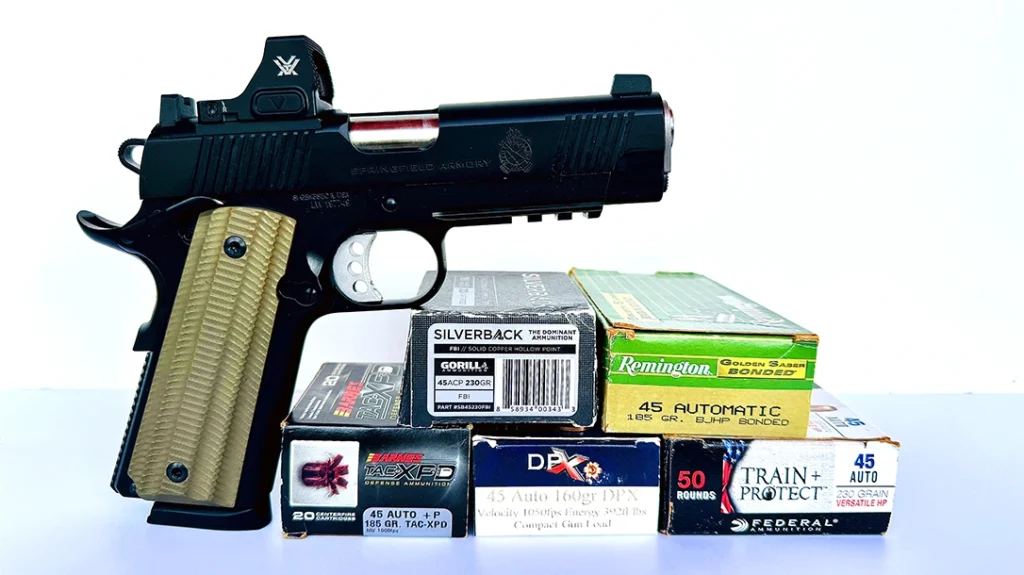
Advertisement — Continue Reading Below
The Operator 4.25 AOS came with two magazines, but having a third when shooting groups is always nice. I like to have three magazines loaded with five rounds each. My third magazine came from Lynn Thompson’s (Cold Steel) Never Unarmed line.
It is an 8-round stainless steel 1911 magazine. The magazine’s body is nearly impervious to the elements, and its state-of-the-art spring and follower assure flawless feeding in your pistol.
For any semi-automatic firearm, reliability is the watchword, and faulty magazines usually cause most malfunctions. This new Never Unarmed magazine eliminates that worry.
Getting Down to Business
My shooting T&E always begins with a chronographing session to measure bullet velocity; the relevant information is in the Performance Table (below).
I did something a little different this time with the Springfield Operator 4.25 AOS. I was curious about which sighting system would be most accurate, the iron sights or optical sight. So, I sent a sight-in type target down to the 10-yard line and fired five shots of the Remington Golden Saber cartridges using first the iron sights and then the Vortex optic.
Shooting was done from the bench, using a sandbag rest, just like I do for the accuracy testing. The iron sight group was fairly well-centered and measured 1.87 inches. The MRDS sight group, discounting a first-shot flyer, measured 1.35 inches and was also well-centered. Interesting.
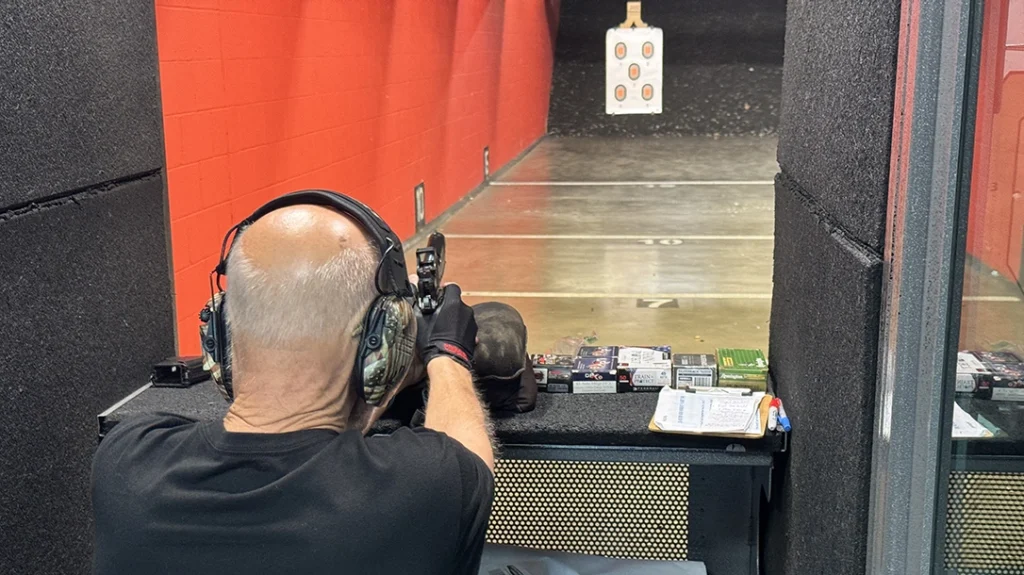
Still at the bench, I sent my multi-bullseye target sheets down to 15 yards and shot three 5-shot groups with each of the .45 ACP test loads. For this phase of the T&E, I deactivated the optical sight and used the iron sights. Not trying to make excuses, but I did find out earlier in the day that I was suffering from tennis elbow. So, my shooting was perhaps a bit off.
At any rate, the best 5-shot group measured 2.42 inches and was made using the Barnes TAC-XPD cartridges. I had a case of 4+1 Syndrome, and a few tight groups were spoiled by a flyer.
I had a nice 4-shot group that measured 1.63 inches with the Gorilla ammo, then round 5 opened it up to 2.63 inches. At any rate, the overall group average totaled 2.67 inches.
Running the Red Dot
I wanted to see just how quickly I could make telling shots using the Vortex Defender-CCW red-dot sight and evaluate the reliability of the Springfield 1911 pistol. So, I devised an exercise that used a reduced-size BC IPSC 12” x 18” Practice Target.
Each of my magazines was loaded with eight rounds of mixed test ammunition. All shooting began with a round chambered, the thumb safety applied, and the pistol in the low-ready position. My Vortex MRDS was adjusted to a medium-bright setting, and I shot with both eyes open.
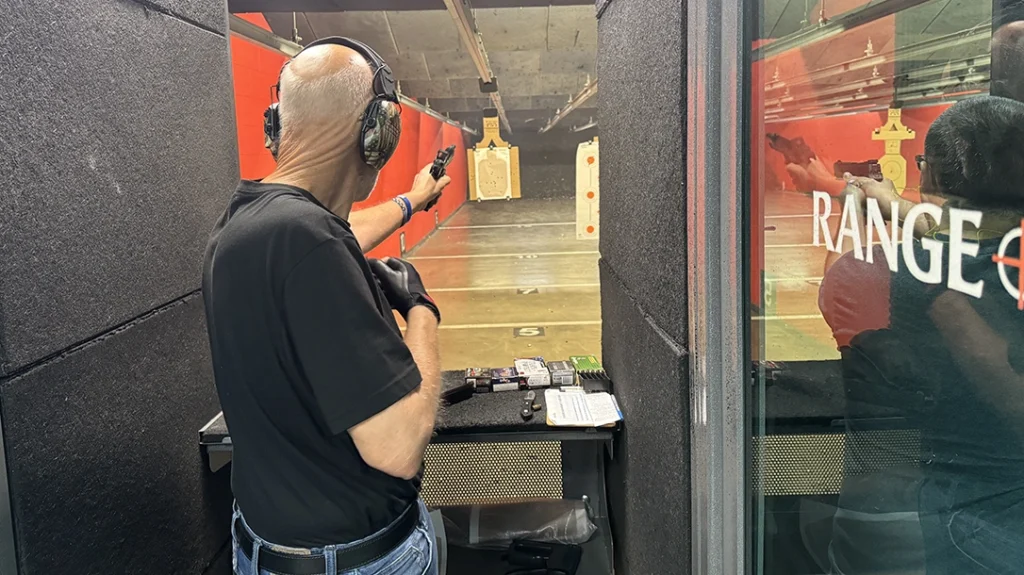
With the target at 5 yards, I raised the pistol, disengaged the safety, and fired four rounds as fast as I could press the trigger and acquire the red dot. This was done with my primary hand only. I repeated this, changed magazines, and did the same drill with my support hand only.
The target was sent to the 10-yard line. Using a two-handed hold, again starting at low-ready, I fired two strings of 4 rounds each, changed magazines, and repeated. I basically did the same thing at 15 yards, slowing my shooting speed slightly for the increased distance.
Operator 4.25 AOS Performance
My exercise consisted of 48 shots fired. I managed to keep all of them inside the tan-colored IPSC target. The majority of the bullet impacts were in the lower C and D zones, with a dozen in the A zone. That red dot gets awful “wobbly” shooting one-handed quickly.
I have had little experience with MRDS. Being a “dinosaur,” I tend to hang little or nothing on my EDC handguns. I did better using both hands at 10 and 15 yards and tried to consciously raise the red dot on the target.
If you transposed that target on a person, all those impacts would be in the thoracic region. That made me feel a bit better and does not reflect negatively on the pistol, sights, or ammunition.
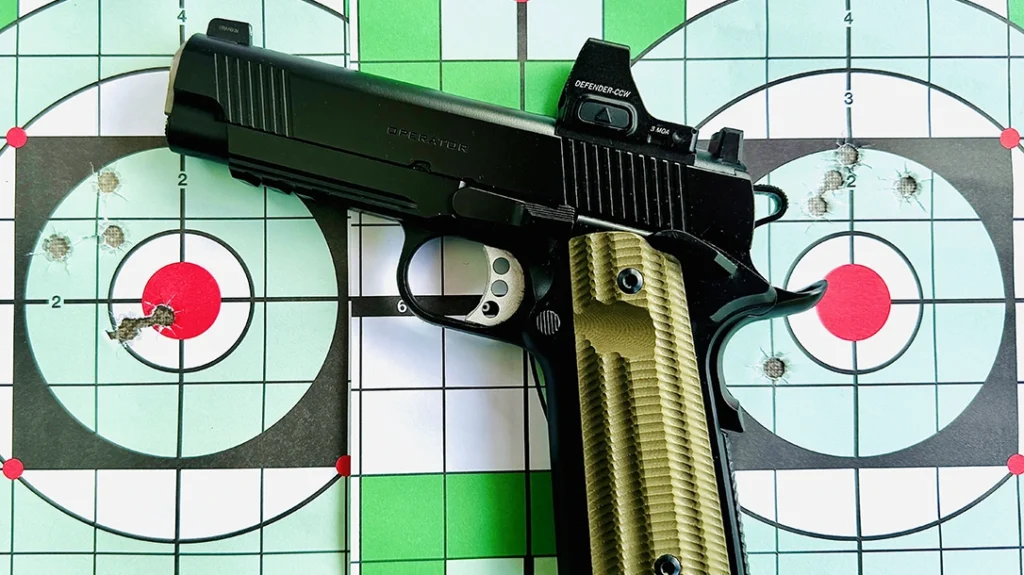
There were no malfunctions during this drill. My only negative comment concerns the magazine catch. Even though the G10 grip panel was dished out just to the rear of the catch, I still could not press the catch enough to drop the empty magazine without shifting my grip. Perhaps a slight extension to the catch would be in order.
Out of 158 shots fired, I only recorded one malfunction, a feed-ramp jam on round #9. Nothing really unusual there for an auto-loader that’s not fully broken in.
The textured G10 grips and mainspring housing contributed greatly to rapid-fire controllability with the Operator 4.25 AOS. Recoil and muzzle-flip with the 32 oz. pistol, plus a full magazine, was very manageable.
Once I was able to fully engage the magazine catch, the magazines ejected with aplomb. I liked that the Springfield/Mec-Gar and Never Unarmed magazines have extended polymer base plates. This makes seating magazines in a hurry easier and protects the magazine when it’s ejected and lands bottom-first on a hard surface.
Parting Shots
Despite my trepidations, I liked the Vortex Defender-CCW sight. I discovered that finding that red dot quickly is easier for me with co-witnessing iron sights. I wouldn’t want them on a handgun that didn’t have backup iron sights—I know Mr. Murphy too well.
If you are looking for a Commander-size 1911 pistol for defensive use, I can certainly recommend this new Springfield offering.
For more information, please visit Springfield-Armory.com.
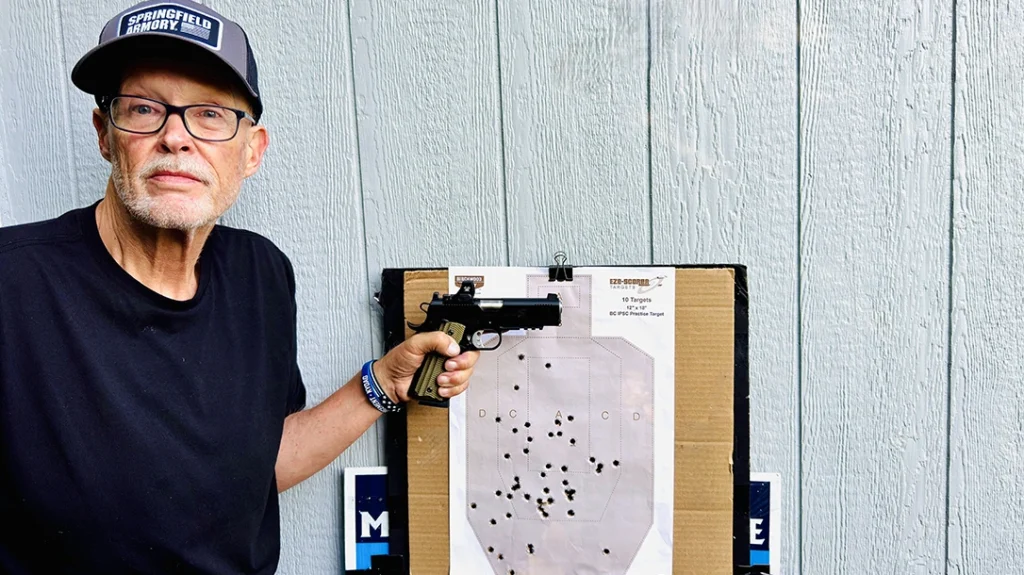
Springfield Armory Operator 4.25 AOS Specs
| Mechanism | Short recoil, locked breech, semi-automatic |
| Caliber | .45 ACP (9mm also available) |
| Capacity | 8+1 cartridges |
| Barrel | 4.25 in. |
| Overall Length | 7.9 in. |
| Empty Weight | 32 oz. |
| Sights | Fixed U-notch rear, Tritium front, optics ready |
| Finish | Black Cerakote |
| Stocks | VZ Grips textured G10 |
| MSRP | $1184.00 |
Performance
| Cartridge | Ave. Velocity | Best Grp. | Ave. Grp. | Ft-Pounds Muzzle Energy |
| Barnes TAC-XPD 185 gr. JHP +P | 983 FPS | 2.42” | 2.68” | 397 FPE |
| Cor® Bon DPX 160 gr. SC-HP | 1017 FPS | 2.63” | 2.83” | 367 FPE |
| Federal Train + Protect 230 gr. VHP | 796 FPS | 2.68” | 2.76” | 324 FPE |
| Gorilla Ammunition Silverback FBI 230 gr. SC-HP | 748 FPS | 2.48” | 2.56” | 286 FPE |
| Remington Golden Saber Bonded 185 gr. B-JHP | 998 FPS | 2.43” | 2.54” | 409 FPE |
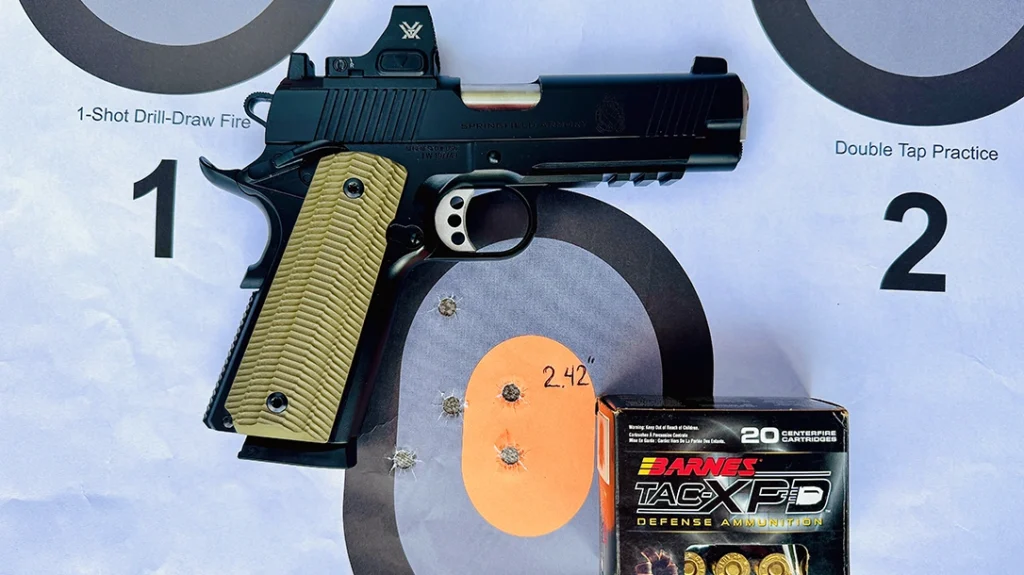
NOTE: Bullet weight measured in grains, velocity in feet per second 10 ft. from the muzzle by an Oehler Model 35P chronograph, and accuracy in inches for three 5-shot groups at 15 yards. FPE based on bullet weight and velocity. SC-HP Solid Copper HP. VHP Versatile HP. B-JHP Brass JHP.
